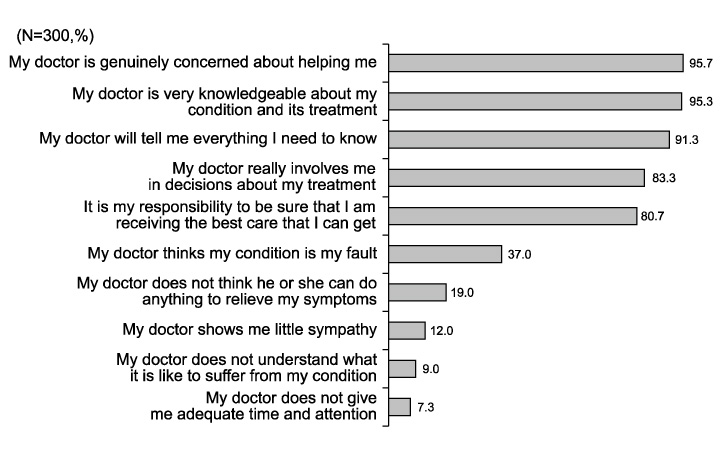Tuberc Respir Dis.
2011 Dec;71(6):400-407.
Awareness and Impact of COPD in Korea: An Epidemiologic Insight Survey
- Affiliations
-
- 1Department of Pulmonary, Allergy and Critical Care Medicine, Hallym University College of Medicine, Seoul, Korea. pulmoks@hallym.ac.kr
- 2Department of Internal Medicine, Samsung Medical Center, Sungkyunkwan University School of Medicine, Seoul, Korea.
- 3Department of Internal Medicine, Seoul National University Hospital, Seoul National University College of Medicine, Seoul, Korea.
- 4Department of Internal Medicine, Yonsei University College of Medicine, Seoul, Korea.
Abstract
- BACKGROUND
There were a few studies which were conducted to know about the behavior of the chronic obstructive pulmonary diseases (COPD) patients. The aims of this study was to explore the behaviour of COPD patients, such as awareness and impact of disease, the pathway of visiting doctors, and the treatment pattern and preference.
METHODS
A face-to-face interview of 300 subjects with COPD was conducted.
RESULTS
The most concerned symptom which made the respondents to visit the hospital was 'breathlessness' (78%). Only 58% of them knew the exact diagnosis. Seventy-three percent of them visited the hospital 'once a month' or 'once every 2 month'. They have made 12.8 prescheduled visits to the hospital in the past 1 year. Unscheduled visits and hospital stay figured to two in the past year. Only 11% of respondents felt they were currently in good health. 'Severe' and 'very severe' COPD patients perceived their health to be in a worse condition than 'mild' and 'moderate' COPD patients. When conditions worsened, 42% of patients were hospitalized. The most common prescription treatment was a fixed combination of inhaled corticosteroids and long-acting beta2 agonists (48%), followed by a long acting anticholinergics (38%).
CONCLUSION
Over forty percent of the patients didn't know exactly about their condition. Most of them had a negative attitude toward their current health status. Doctors need to know more about COPD patients in terms of their attitude toward the disease, impact of the disease, interaction with healthcare professionals and treatment related problems.
MeSH Terms
Figure
Reference
-
1. Lopez AD, Mathers CD, Ezzati M, Jamison DT, Murray CJ. Global and regional burden of disease and risk factors, 2001: systematic analysis of population health data. Lancet. 2006. 367:1747–1757.2. Global strategy for the diagnosis, management, and prevention of chronic obstructive pulmonary disease. 2006 Revision. Global Initiative for Chronic Obstructive Lung Disease (GOLD). 2006. cited 2007 Jan 25. GOLD;Available from: URL: http://www.goldcopd.org/uploads/users/files/GOLDReport2006_0122.pdf.3. Rennard S, Decramer M, Calverley PM, Pride NB, Soriano JB, Vermeire PA, et al. Impact of COPD in North America and Europe in 2000: subjects' perspective of Confronting COPD International Survey. Eur Respir J. 2002. 20:799–805.4. Kim DS, Kim YS, Jung KS, Chang JH, Lim CM, Lee JH, et al. Prevalence of chronic obstructive pulmonary disease in Korea: a population-based spirometry survey. Am J Respir Crit Care Med. 2005. 172:842–847.5. Kim YS, Byun MK, Jung WY, Jeong JH, Choi SB, Kang SM, et al. Validation of the Korean version of the St. George's Respiratory Questionnaire for patients with chronic respiratory disease. Tuberc Respir Dis. 2006. 61:121–128.6. Shim YS. Epidemiological survey of chronic obstructive pulmonary disease and alpha-1 antitrypsin deficiency in Korea. Respirology. 2001. 6:S9–S11.7. Zielinski J, Bednarek M, Górecka D, Viegi G, Hurd SS, Fukuchi Y, et al. Increasing COPD awareness. Eur Respir J. 2006. 27:833–852.8. Buist AS, McBurnie MA, Vollmer WM, Gillespie S, Burney P, Mannino DM, et al. International variation in the prevalence of COPD (the BOLD Study): a population-based prevalence study. Lancet. 2007. 370:741–750.9. Menezes AM, Perez-Padilla R, Jardim JR, Muiño A, Lopez MV, Valdivia G, et al. Chronic obstructive pulmonary disease in five Latin American cities (the PLATINO study): a prevalence study. Lancet. 2005. 366:1875–1881.10. Fukuchi Y, Nishimura M, Ichinose M, Adachi M, Nagai A, Kuriyama T, et al. COPD in Japan: the Nippon COPD Epidemiology study. Respirology. 2004. 9:458–465.11. Regional COPD Working Group. COPD prevalence in 12 Asia-Pacific countries and regions: projections based on the COPD prevalence estimation model. Respirology. 2003. 8:192–198.12. Rutten-van Mölken MP, Oostenbrink JB, Tashkin DP, Burkhart D, Monz BU. Does quality of life of COPD patients as measured by the generic EuroQol five-dimension questionnaire differentiate between COPD severity stages? Chest. 2006. 130:1117–1128.13. Carrasco Garrido P, de Miguel Díez J, Rejas Gutiérrez J, Centeno AM, Gobartt Vázquez E, Gil de Miguel A, et al. Negative impact of chronic obstructive pulmonary disease on the health-related quality of life of patients. Results of the EPIDEPOC study. Health Qual Life Outcomes. 2006. 4:31.14. Kessler R, Ståhl E, Vogelmeier C, Haughney J, Trudeau E, Löfdahl CG, et al. Patient understanding, detection, and experience of COPD exacerbations: an observational, interview-based study. Chest. 2006. 130:133–142.15. Wyrwich KW, Metz SM, Kroenke K, Tierney WM, Babu AN, Wolinsky FD. Measuring patient and clinician perspectives to evaluate change in health-related quality of life among patients with chronic obstructive pulmonary disease. J Gen Intern Med. 2007. 22:161–170.
- Full Text Links
- Actions
-
Cited
- CITED
-
- Close
- Share
- Similar articles
-
- Awareness of COPD in a High Risk Korean Population
- Implications of Managing Chronic Obstructive Pulmonary Disease in Cardiovascular Diseases
- A Literature Review on Asthma and Chronic Obstructive Pulmonary Disease Among Domestic and Overseas Farmers
- Awareness of chronic obstructive pulmonary disease in current smokers: a nationwide survey
- Related Factors of Quality of Life in Male Patients with Chronic Obstructive Pulmonary Disease






